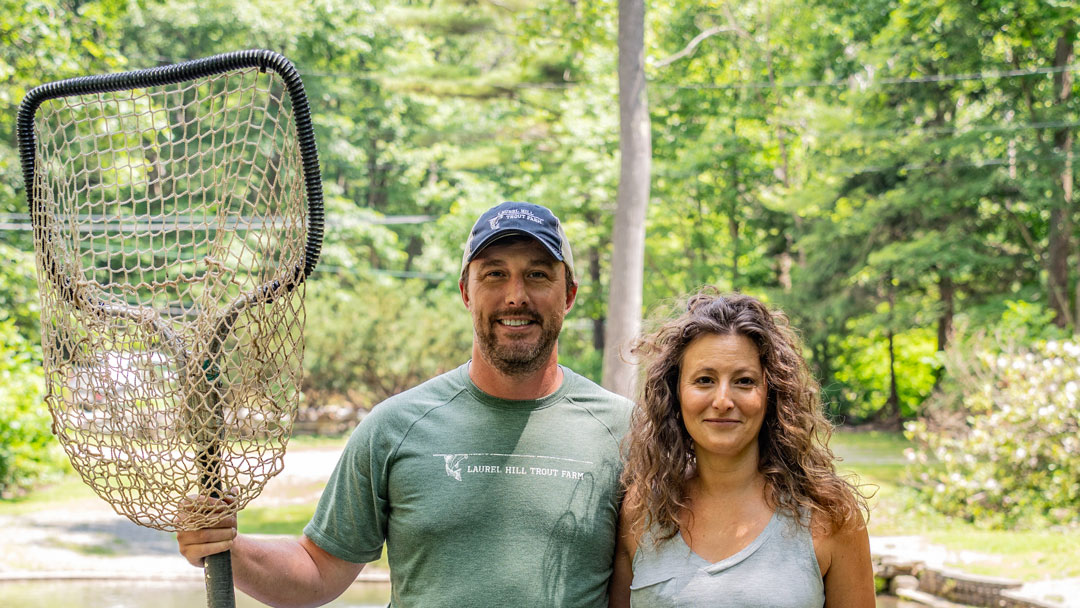Pritts family trout farm adapts as industry changes
Story and photos by William Whisler
For almost 60 years, Adam Pritts’ family has been involved in aquaculture.
The family business began years after Adam’s great grandfather was exposed to
trout farms in Austria when he was stationed overseas during World War II and continues today as one of the East Coast’s premier trout hatcheries and pond and stream management supply stores.

- Top Left: Adam and Liz Pritts, own and operate Laurel Hill Trout Farm, which has eight locations in Southwestern Pennsylvania and Northwestern Virginia.
- Top Right: The Pritts’ trout start in a hatch house before transitioning to raceways.
- Bottom: Trout are kept in free-flowing waterways, called raceways where they will stay until they are stocked or processed.
Pritts’ maternal grandfather, Clair Bassett, owned and operated an oil business in York, before deciding to purchase a farm that came up for sale in 1964. From there, Laurel Hill Trout Farm has evolved into one of the biggest operations on the East Coast, as Adam and his wife, Liz, have expanded the company to include eight different trout farms across Southwestern Pennsylvania and Northwestern Virginia.
Pritts took over the family farm in 2005, and has seen constant changes to the industry, as larger-scale fish farms have become the norm.
Today, Laurel Hill Trout Farm offers customers across Pennsylvania, Ohio, West Virginia and Virginia trout broodstock, bulk-order trout fillets to retailers and consumers, as well as public and private fee fishing at two locations.
Raising Trout
When it comes to raising the trout, Laurel Hill Trout Farm starts with its own eggs, as it maintains broodstock at the Osterburg and Newville locations. In Virginia, Pritts purchases eggs from other big farms that specialize in production.
The biggest thing for growing trout is water temperature. A few degrees of difference can make a big impact in the speed of growth for Pritts’ trout.
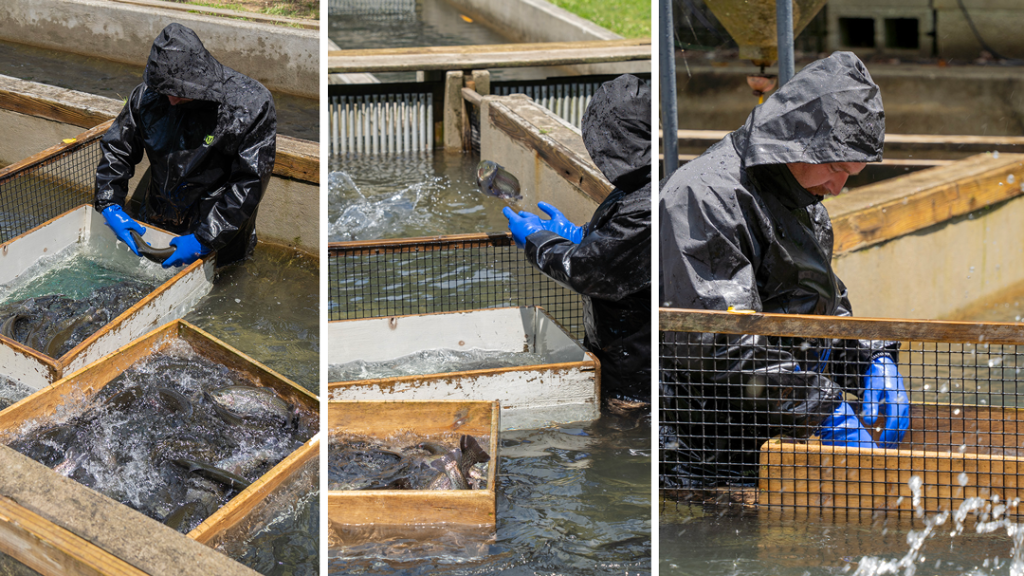
“Water temperature plays a big part in the lifecycle of how a fish can metabolize. The range of 58-59 degrees is ideal. If you go above that, their metabolisms are going to slow down and they won’t grow as quickly,” Pritts said. “With our own eggs, from the time we take them until they hatch is usually about 36-50 days, depending on the species. After the sac fry is gone, we start to hand feed or use a mechanical feeder to feed them 8-12 times per day. This all takes place in a hatch house.
Pritts said that his trout average about an inch or two inches of growth per month, depending on the farm.
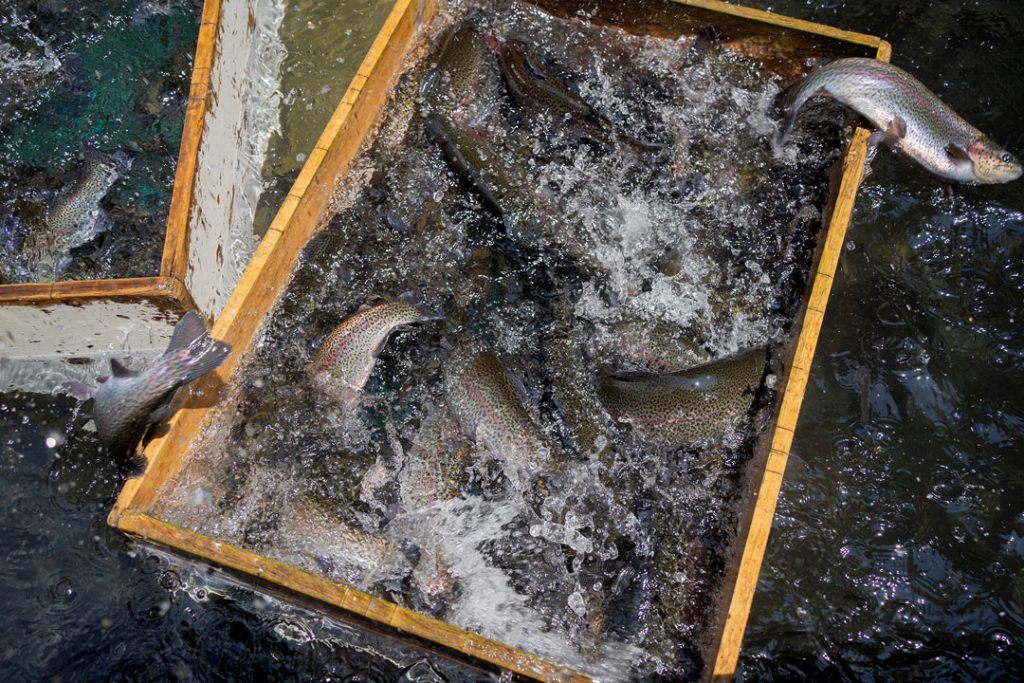
“They’re going to average anywhere from about an inch to two inches per month, in growth. We have a couple farms in Virginia that have a constant water temperature and it’s warmer because its spring fed, but the springs come out warmer than anything I have in Pennsylvania, they’re 56 degrees or so really close to that ideal range, okay? Those farms might come close to two inches a month. Typically like in our Pennsylvania hatch houses, I can get an inch a month. That’s about what we can do and that’s only a difference from like 50 to 52 degrees, but those four degrees is a big swing on growth rate. By the time they get about three or four inches long, we move them outside into raceways or they go to a different farm.”
The cycle for trout on the farm runs between 12-to-16 months, depending on the farm.
Bird Damage
One of the biggest challenges that Pritts faces at Laurel Hill Trout Farm is the threat of blue herons and other types of birds, such as bald eagles and ospreys that eat and injure fish. Bears have also proven to be an issue but not to the same scale as the blue herons, which come out in droves to eat the trout. A heron cannot be killed without a depredation permit that would need to be signed off by the Game Commission, U.S. Fish and Wildlife Service and USDA, making limiting bird damage a huge task.
Blue herons are protected as a migratory species, making them a consistent issue. One scare tactic that Pritts has used has been to use an inflatable tube man that flails back and forth over the raceways.
“One of the best things we found so far is I call them a sky dancer, like those flappy things you see on a used car lot. We put those on timers and it looks goofy. You see a trout farm and then about every 20 minutes this big sock puppet blows up and flaps around,” Pritts said. “Normally we don’t have problems with any birds what I would call normal working hours. They are used to seeing activity and stay away, but they have like an internal clock. At quitting time, you start to see them flying in. Eventually they figure out this flappy thing isn’t going to hurt us.”
The losses associated with herons are not small for Laurel Hill Trout Farm, especially considering young birds tend to injure more fish than they eat. A heron can eat a pound of fish in an evening.
“They kill a lot more than they eat. If they eat a pound, they might injure another pound. If you’ve got 30 birds on the farm eating, that’s 60 pounds lost in a night. If they’re on small fish, which they love, they have a lot harder time with them. They might put a hole in their back and try to flip them out. There have been single years where I’ve known we’ve lost 50-to-100,000 fish because of herons.”
Pritts noted that they’ve attempted to use netting to keep herons out of the raceways, but doing so can cause other issues. If a bear comes in, it can step on them and crush the netting, which results in the death of many fish.
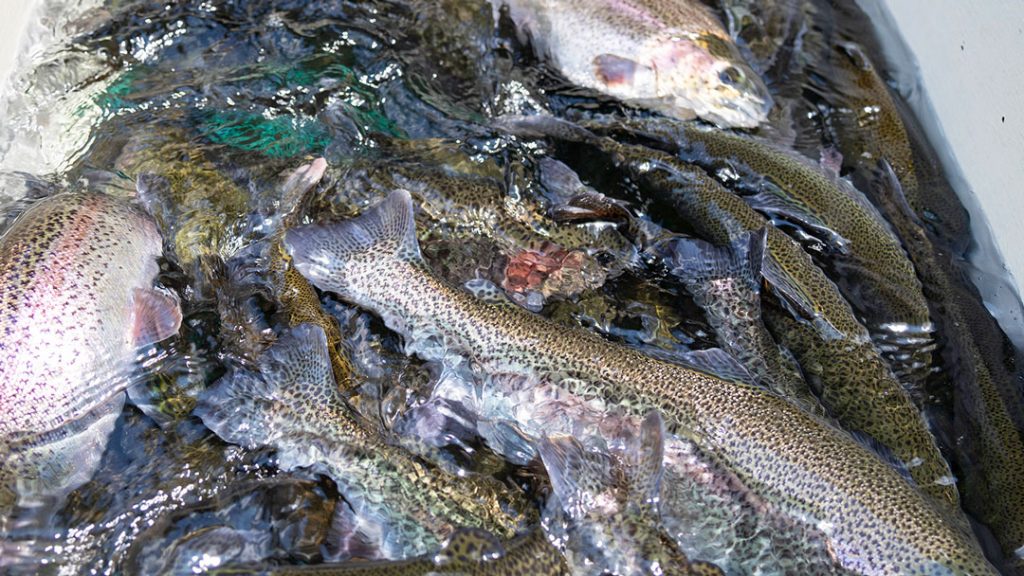
Cornering the Market
Laurel Hill Trout Farm produces a ton of fish in a year. Most of its sales come from fish stocking or the wholesale market.
“In a typical year we probably hatch one million to 1.2 million fish,” Pritts said. “Between all our farms we probably average 5-600,000 pounds of fish. We also sell a lot of fingerlings to other farms. At any given moment, we probably have a million fish between all the farms, but a lot of the weight will be in small fish. They don’t amount for the bulk of the weight, but they amount for the bulk of the numbers.”
Pritts estimates that about 70 percent of his business comes from stocking, with the other 30 percent coming from selling fish fillets.
“(Today) stocking is probably around 70 percent of our business and the other 30 percent is what I would call processing – by processing, I mean trout we turn into fillets,” Pritts said. “In the past it was probably more like 85-15. From a business model standpoint, the stocking provides a slightly higher margin, but it comes with a considerable extra cost because you have to have employees to truck fish, because you are doing live deliveries of fish. When you’re hauling water weight, you might have 10-12,000 pounds on a truck and only 2,000 of it is fish. You’re hauling water weight, which is super expensive.”
With the technology needed to keep the fish alive on the truck, employees need specific training to deliver Laurel Hill Trout Farm’s fish.
“It’s not like you can just pull any truck driver off the street and ask them to hop in the fish truck,” Pritts said. “You have to know how the aeration systems work and what the fish should look like. It takes a lot of training along with stocking. We maintain an average fleet of 15 to 20 trucks that we use primarily for stocking. Stocking offers a slightly higher price point, but it’s a lot more labor intensive. Your sales are jumping March, April, May, so it doesn’t allow for even production.”
Pritts said he has decided to dive more into the food market, due to it being a smoother, more consistent option with less cost tied up in transporting fish.
“It’s a much more even cash flow model. We have a processing plant in our one farm in Virginia and that’s where we process everything,” Pritts said. “But if I want to haul 2,000 pounds live weight of fish, if we’re hauling that for stocking, we will end up hauling like 14,000 pounds of water and fish, plus all the gear to haul them in. This way, I take the same 2,000 pounds of fish, fillet them, and now we’ve gotten about a 50 percent yield, and I only have to haul 1,000 pounds of product in boxes that can’t die on the way there. It just goes in the back of a van in a refrigerated tote thing, and we have to keep it cold. So, distribution wise, it’s so much less.”
Laurel Hill Trout Farm sells its fish fillets wholesale to retailers who then distribute the fillets to restaurants.
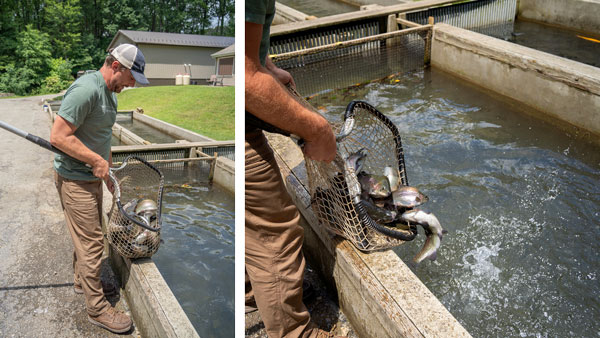
“Everything we offer is frozen and vacuum sealed, although I do wholesale some fresh fillets,” Pritts said. “We fillet it designed to be frozen, so it’s not like traditional frozen seafood, which gets a little bit of a bad rap, because standard practices will keep fish fresh until it is at about the end of its shelf life and then when it gets to its shelf life, they decide to freeze it. That is not a good way to get frozen fish. We fillet everything, pin bone it and package it, and it is not sitting there for two weeks before we decide to freeze it. It is maybe two days and then vacuum sealed and froze. It gets you a much better-quality frozen product. We do mainly frozen fish because if we are dealing with a restaurant, they don’t end up with spoilage. If they don’t sell out of fish, then they are only defrosting what they need.”
Stocking also has many other challenges, including constantly changing and complicated regulations.
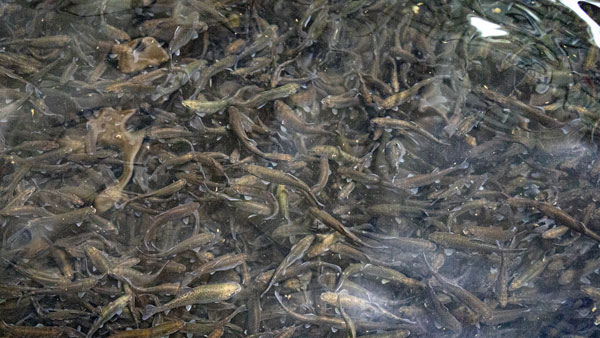
“I’m not going after new stocking business as much anymore. New business that we go after, we try to target the food markets. This is not just something that we are doing. This is something country wide that you are seeing with farmers who traditionally relied around stocking,” Pritts said. “The rules around it have continued to change and continue to become way more complicated. Even if you can comply, it doesn’t mean that the customer wants to go through the hassle of compliance. It discourages stocking to some degree and then you have some businesses that rely on it. It pushes you to look at things that are more stable and that drives you to the food market.”
Industry Changes
Pritts has noticed farmers going away from pursuing stocking opportunities in favor of the food market, due to the unpredictability of it, different state regulations and the need to have mass production for a short period of time.
“I’m not really out looking for new stocking customers but if someone wants to come on, we aren’t turning people down, but at the same time, it’s not where my efforts necessarily go because it’s just so unpredictable,” Pritts said. “The food industry has actually become more predictable and comfortable. There’s still regulatory stuff on the food side, but it’s a much more predictable and stable side.”
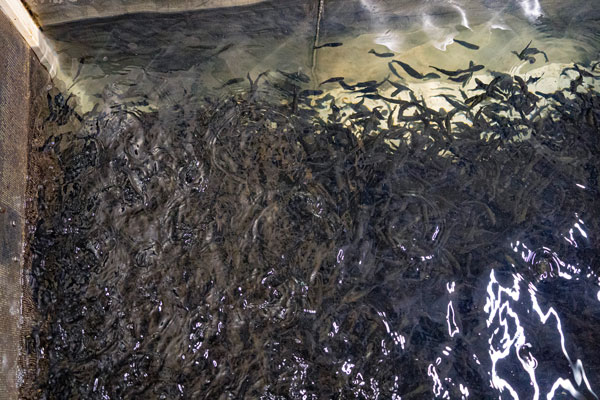
Over the years trout farms have grown into mainly a small set of large-scale farms. Pritts hopes to continue with his eight farms but has shown he’s not afraid to grow when opportunities arise. The Pritts’ family will continue to play a big role in the trout industry for years to come.
“The industry has really gotten to the point of you’re either going to get bigger or
you’re going to get out,” Pritts said. “Within 10-15 years I’d be surprised if there are more than two main companies with the level of consolidation that happens to keep anything cost effective. On the food side, the one place we do compete with is Idaho. Something like 80 percent of U.S. trout production is in Idaho. It makes really anything any farmer does East of the Mississippi look tiny. Small farms out there might raise one million pounds of fish. They dominate the food market and it’s cost effective for them to do it. I think largely, that same thing will happen on the East Coast.”

